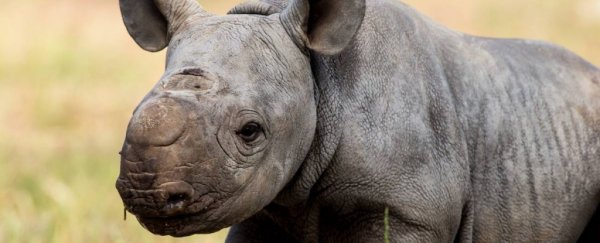Australia's Taronga Western Plains Zoo has a new resident - a new baby black rhino, born to mum Bakhita and dad Kwanzaa.
Born on Halloween, the new calf is yet to be named, but he's the second black rhino calf the zoo has welcomed this year as part of its concerted black rhino breeding program.
"We are very happy with the arrival of a healthy male calf born overnight on 31 October," said rhino keeper Scott Smith.
"Every birth is special but to have two black rhino calves born in one year is particularly exciting. We're thrilled."
The black rhino (Diceros bicornis) is critically endangered. It was once the world's most numerous rhino species, with numbers as high as 850,000, but today estimates put the number of animals at fewer than 5,500.
The primary reason for this decline is habitat loss due to agricultural clearing - and highly aggressive poaching for the animals' horns, the illegal sale of which can fetch a massive US$60,000 per kilogram (around US$27,000 per pound) on the black market.
Black rhino numbers hit their lowest in 1995, when they dropped to just 2,410 individuals. They have been slowly rising again, but there's still a long road ahead.
To help the black rhino conservation effort, zoos around the world have implemented breeding programs.
Taronga Western Plains Zoo, which has large habitats for its animals and a focus on animal conservation, acquired six black rhinos for its breeding program in 1994.
Since then, they have seen the births of 14 black rhino calves, so two in one year is amazing.
"The birth occurred in the early hours of Halloween, following a 15-month gestation period for Bakhita. It was a smooth delivery and the calf is strong, healthy and well," Scott said.
"The new calf is one of the biggest black rhino calves born here at the Zoo, with an estimated birth weight of 35 to 40 kilograms [around 80 lbs]. We're pleased to see he is suckling very well from Bakhita."
Bakhita herself was born at the zoo in 2002 - its first female calf. This makes the new arrival second-generation, although impressively, the zoo actually hosts three rhino generations. A female calf named Mesi was born at the zoo in April of this year - to Bakhita's daughter, Kufara.
According to the zoo, the new baby is settling in well. He has been getting to know his human handlers in a "creep" yard, an enclosure with an opening that he can fit through, but Bakhita can't.
She can hover safely nearby. Although he won't eat solid food until he's three months old, he's also been practicing by mouthing leaves.
"He has already been seen galloping around his behind the scenes enclosure and venturing a considerable distance from Bakhita for short periods of time," Scott said.
"He's an active calf and is very inquisitive about his surroundings."
For now, he's going to remain behind the scenes so mum and baby can bond, but they'll make their public debut early next year.
